Effective presentations TYPES OF PRESENTATIONS •


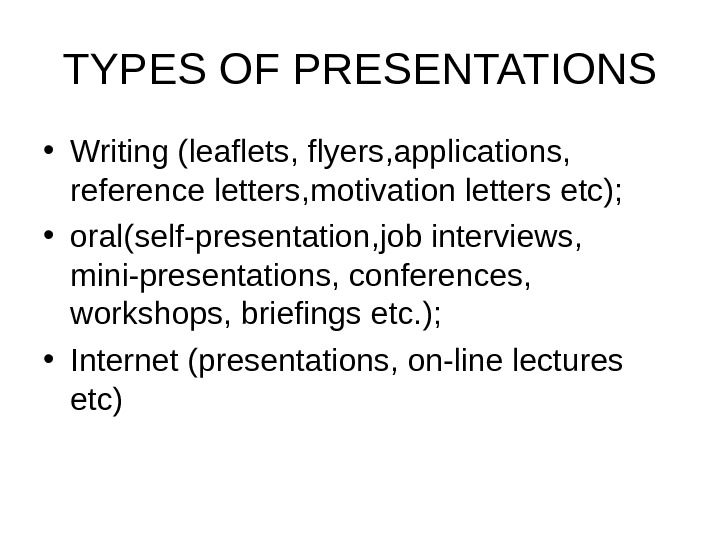
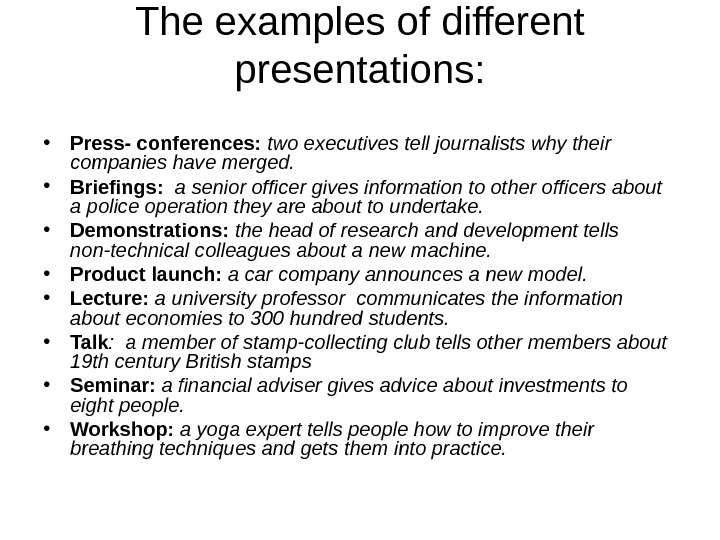
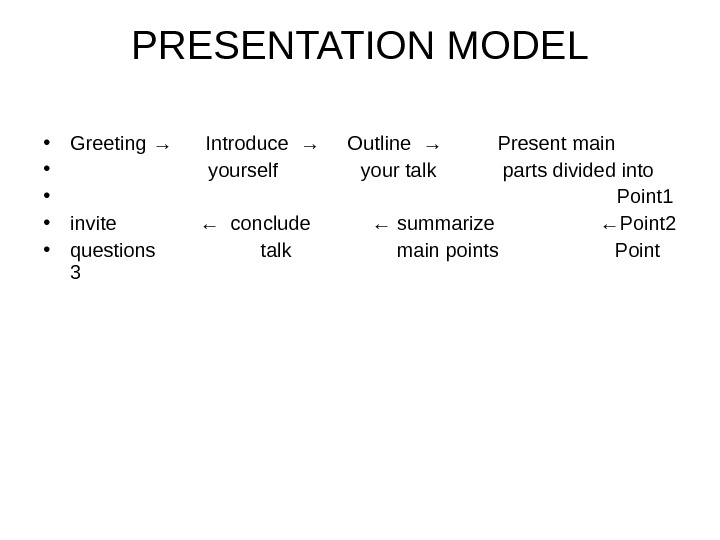


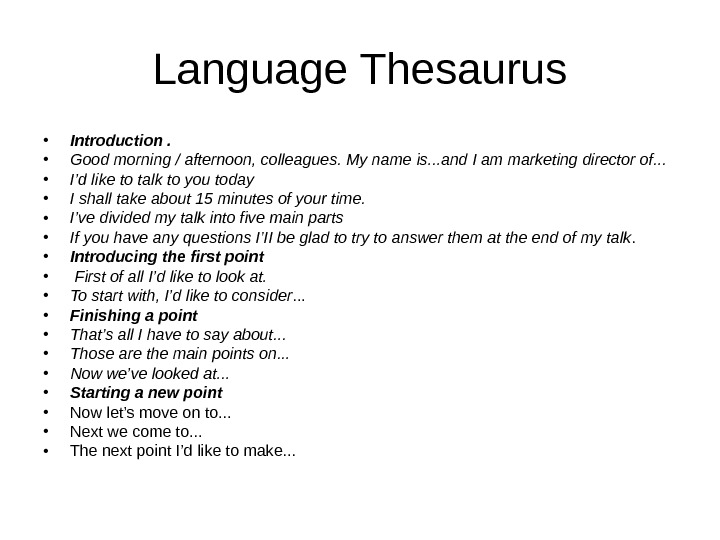
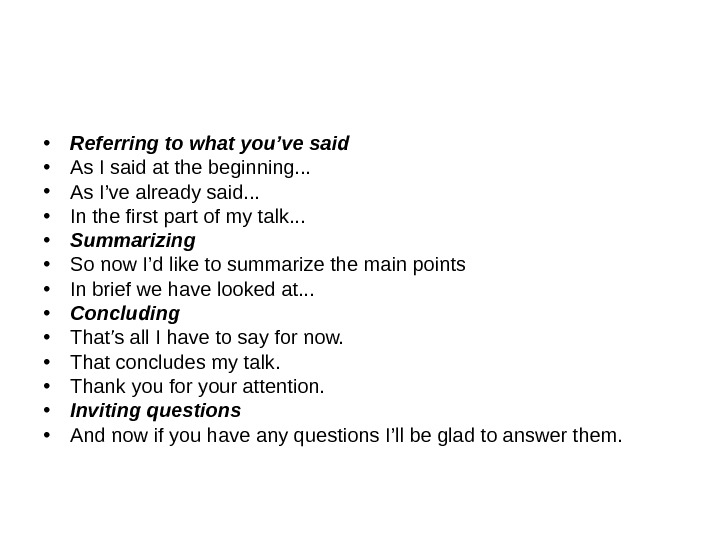

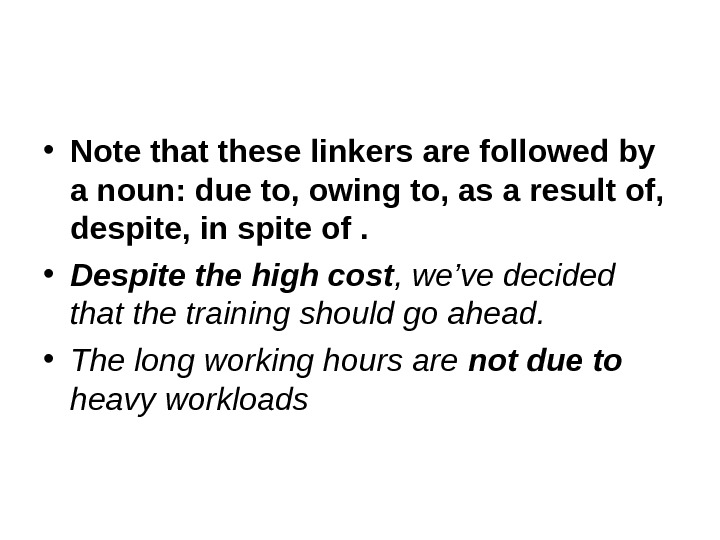
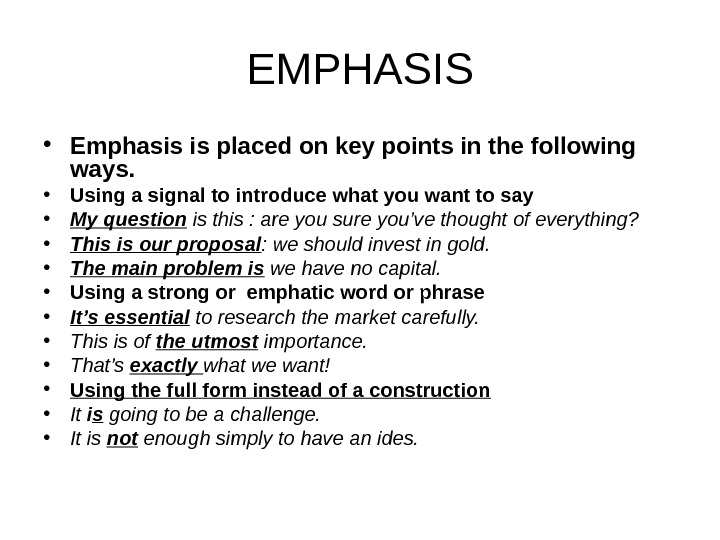


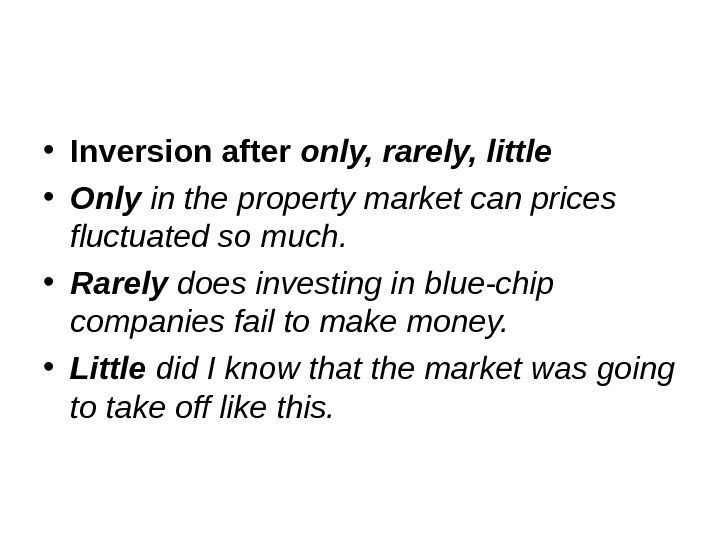
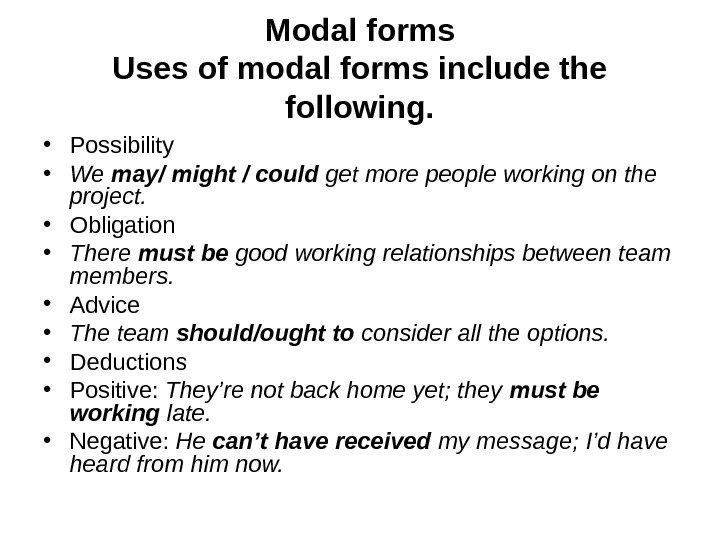


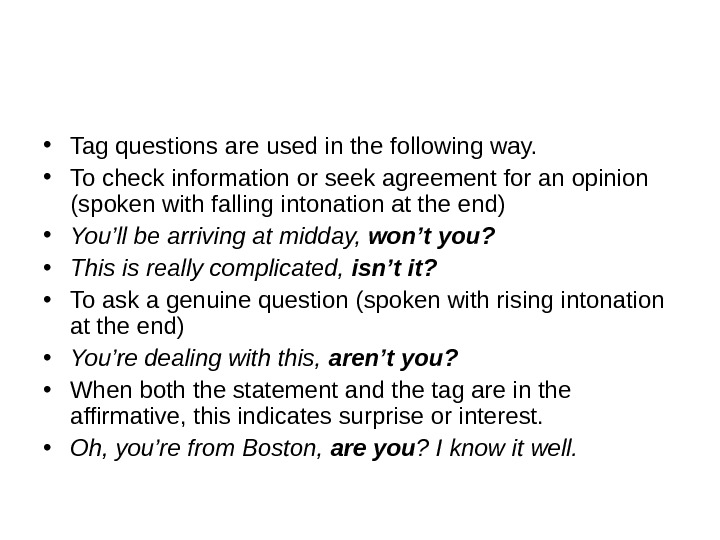

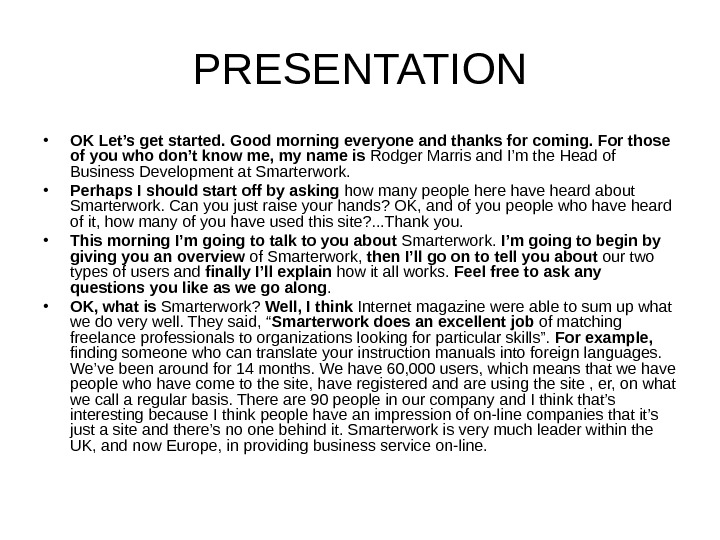


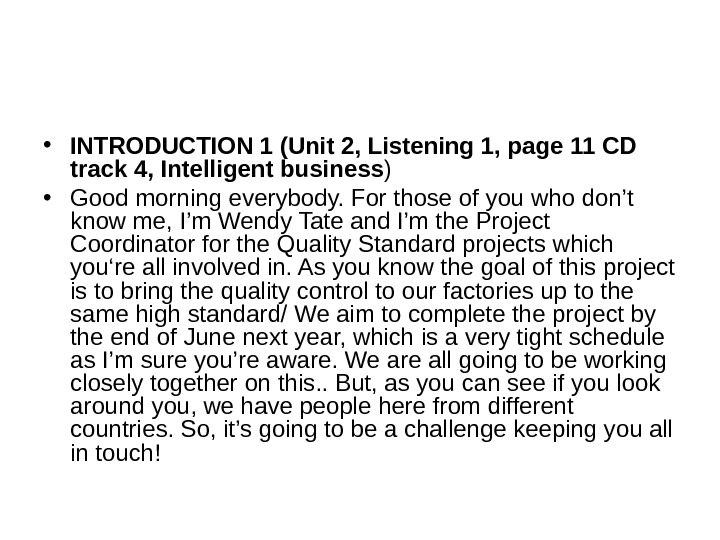
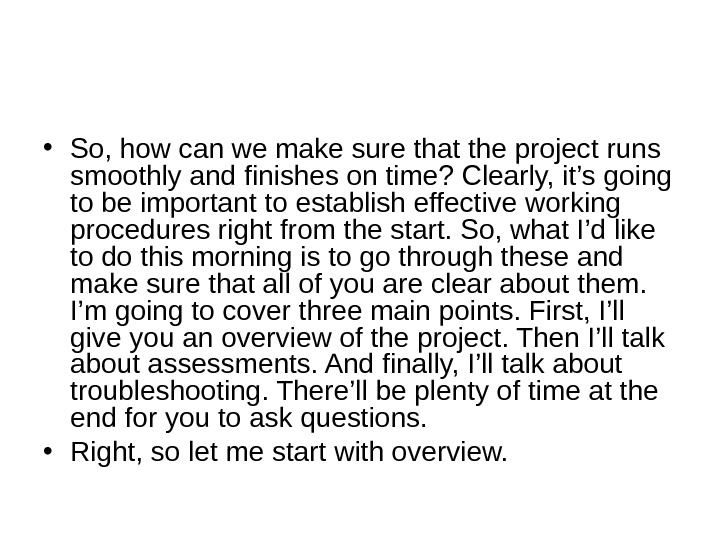




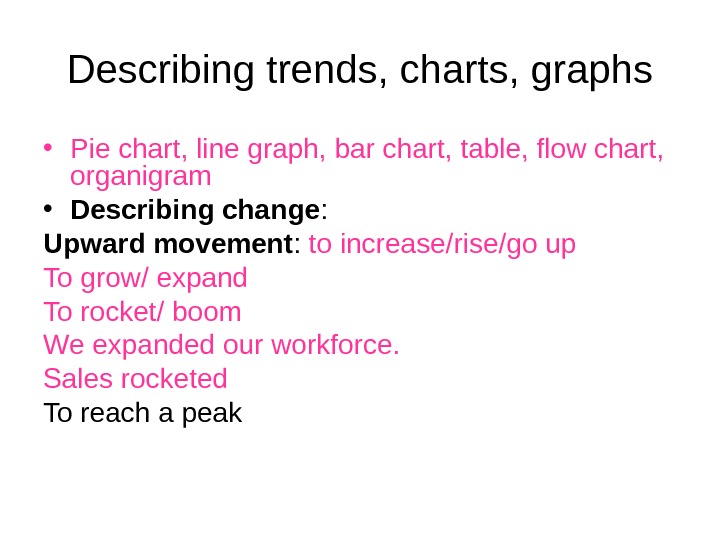

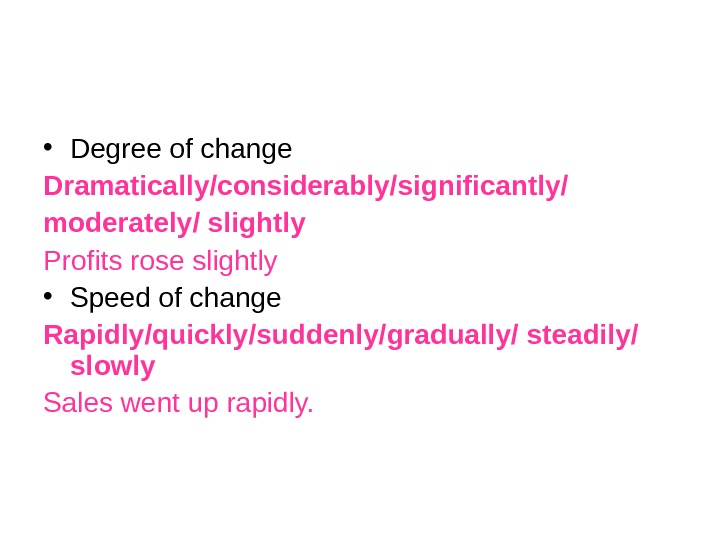
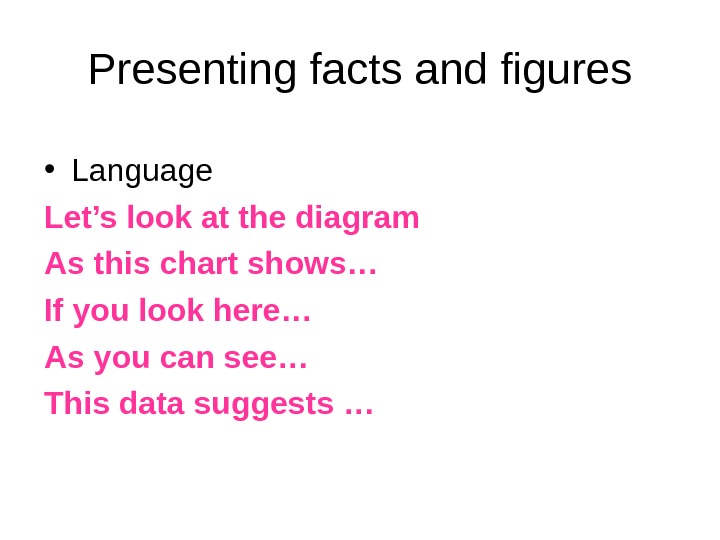


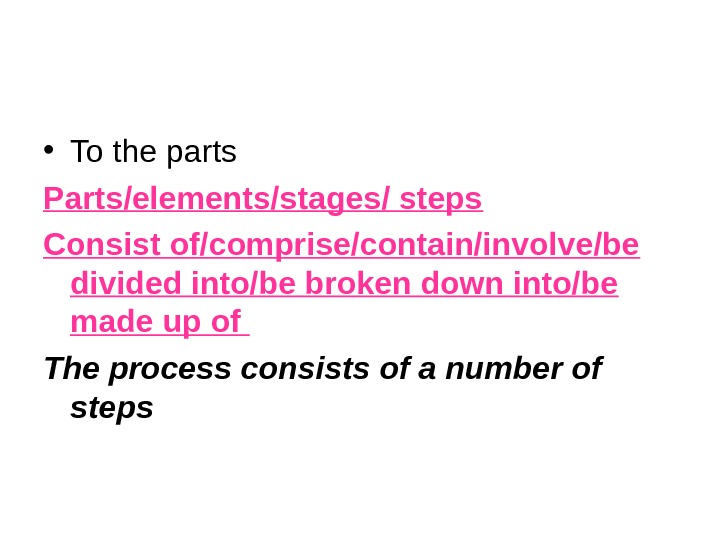




effective_presentations.students.ppt
- Размер: 80.5 Кб
- Количество слайдов: 39
Описание презентации Effective presentations TYPES OF PRESENTATIONS • по слайдам
 Effective presentations
Effective presentations
 TYPES OF PRESENTATIONS • Writing (leaflets, flyers , applications, reference letters , motivation letters etc ); • oral ( self-presentation , job interviews , mini-presentations, conferences, workshops, briefings etc. ); • Internet (presentations, on-line lectures etc)
TYPES OF PRESENTATIONS • Writing (leaflets, flyers , applications, reference letters , motivation letters etc ); • oral ( self-presentation , job interviews , mini-presentations, conferences, workshops, briefings etc. ); • Internet (presentations, on-line lectures etc)
 The examples of different presentations: • Press- conferences: two executives tell journalists why their companies have merged. • Briefings: a senior officer gives information to other officers about a police operation they are about to undertake. • Demonstrations: the head of research and development tells non-technical colleagues about a new machine. • Product launch: a car company announces a new model. • Lecture: a university professor communicates the information about economies to 300 hundred students. • Talk : a member of stamp-collecting club tells other members about 19 th century British stamps • Seminar: a financial adviser gives advice about investments to eight people. • Workshop: a yoga expert tells people how to improve their breathing techniques and gets them into practice.
The examples of different presentations: • Press- conferences: two executives tell journalists why their companies have merged. • Briefings: a senior officer gives information to other officers about a police operation they are about to undertake. • Demonstrations: the head of research and development tells non-technical colleagues about a new machine. • Product launch: a car company announces a new model. • Lecture: a university professor communicates the information about economies to 300 hundred students. • Talk : a member of stamp-collecting club tells other members about 19 th century British stamps • Seminar: a financial adviser gives advice about investments to eight people. • Workshop: a yoga expert tells people how to improve their breathing techniques and gets them into practice.
 PRESENTATION MODEL • Greeting → Introduce → Outline → Present main • yourself your talk parts divided into • Point 1 • invite ← conclude ← summarize ←Point 2 • questions talk main points Point
PRESENTATION MODEL • Greeting → Introduce → Outline → Present main • yourself your talk parts divided into • Point 1 • invite ← conclude ← summarize ←Point 2 • questions talk main points Point
 Preparation and planning • 1. Think about your objective • What will be the change you wish to bring about in your audience? • Do you want to inform them, amuse them, persuade them or train them? Or combination of these? • 2. Think about the audience • What type of people are they? • How many will their be • What is their level of knowledge on the subject? • 3. Think about the time • 4. Think about the location (site) • A quick checklist: • Why do you want to speak to this audience • What will they expect to get out of it ? • What main points do you want to make? • What sort of rapport do you wish to establish with your audience? • How would you expect them to react?
Preparation and planning • 1. Think about your objective • What will be the change you wish to bring about in your audience? • Do you want to inform them, amuse them, persuade them or train them? Or combination of these? • 2. Think about the audience • What type of people are they? • How many will their be • What is their level of knowledge on the subject? • 3. Think about the time • 4. Think about the location (site) • A quick checklist: • Why do you want to speak to this audience • What will they expect to get out of it ? • What main points do you want to make? • What sort of rapport do you wish to establish with your audience? • How would you expect them to react?
 Non-verbal communication or body language is an essential part of face-to-face self-presentation • Non-verbal communication or body language is an essential part of face- to -face self-presentation since it has a direct effect on the perception and attitude of those about us. Body language will affect credibility of what is said. The ability to control body language so as it conveys the right image is therefore an important skill to master. • When we are speaking our listeners are using our: • eye contact and movement; • facial expression; • gestures; • postures; • touch and proximity
Non-verbal communication or body language is an essential part of face-to-face self-presentation • Non-verbal communication or body language is an essential part of face- to -face self-presentation since it has a direct effect on the perception and attitude of those about us. Body language will affect credibility of what is said. The ability to control body language so as it conveys the right image is therefore an important skill to master. • When we are speaking our listeners are using our: • eye contact and movement; • facial expression; • gestures; • postures; • touch and proximity
 Language Thesaurus • Introduction. • Good morning / afternoon, colleagues. My name is. . . and I am marketing director of. . . • I’d like to talk to you today • I shall take about 15 minutes of your time. • I’ve divided my talk into five main parts • If you have any questions I’II be glad to try to answer them at the end of my talk. • Introducing the first point • First of all I’d like to look at. • To start with, I’d like to consider. . . • Finishing a point • That’s all I have to say about. . . • Those are the main points on. . . • Now we’ve looked at. . . • Starting a new point • Now let’s move on to. . . • Next we come to. . . • The next point I’d like to make. . .
Language Thesaurus • Introduction. • Good morning / afternoon, colleagues. My name is. . . and I am marketing director of. . . • I’d like to talk to you today • I shall take about 15 minutes of your time. • I’ve divided my talk into five main parts • If you have any questions I’II be glad to try to answer them at the end of my talk. • Introducing the first point • First of all I’d like to look at. • To start with, I’d like to consider. . . • Finishing a point • That’s all I have to say about. . . • Those are the main points on. . . • Now we’ve looked at. . . • Starting a new point • Now let’s move on to. . . • Next we come to. . . • The next point I’d like to make. . .
 • Referring to what you’ve said • As I said at the beginning. . . • As I’ve already said. . . • In the first part of my talk. . . • Summarizing • So now I’d like to summarize the main points • In brief we have looked at. . . • Concluding • That’s all I have to say for now. • That concludes my talk. • Thank you for your attention. • Inviting questions • And now if you have any questions I’ll be glad to answer them.
• Referring to what you’ve said • As I said at the beginning. . . • As I’ve already said. . . • In the first part of my talk. . . • Summarizing • So now I’d like to summarize the main points • In brief we have looked at. . . • Concluding • That’s all I have to say for now. • That concludes my talk. • Thank you for your attention. • Inviting questions • And now if you have any questions I’ll be glad to answer them.
 Linking ideas • Relative clauses • The following linking words and phrases introduce clauses • Cause: because, as, since • The company will benefit because the staff will be more motivated • Purpose: in order to, so that • In order to improve working conditions, we need to invest in new equipment. • Concession : although, though • Though the budget is tight, we can still afford it. • Contrast : while, whereas • Competitors invested in technology while we did not. • Similarity: as, like • We must put more emphasis on training, as they do in other companies.
Linking ideas • Relative clauses • The following linking words and phrases introduce clauses • Cause: because, as, since • The company will benefit because the staff will be more motivated • Purpose: in order to, so that • In order to improve working conditions, we need to invest in new equipment. • Concession : although, though • Though the budget is tight, we can still afford it. • Contrast : while, whereas • Competitors invested in technology while we did not. • Similarity: as, like • We must put more emphasis on training, as they do in other companies.
 • Note that these linkers are followed by a noun: due to, owing to, as a result of, despite, in spite of. • Despite the high cost , we’ve decided that the training should go ahead. • The long working hours are not due to heavy workloads
• Note that these linkers are followed by a noun: due to, owing to, as a result of, despite, in spite of. • Despite the high cost , we’ve decided that the training should go ahead. • The long working hours are not due to heavy workloads
 EMPHASIS • Emphasis is placed on key points in the following ways. • Using a signal to introduce what you want to say • My question is this : are you sure you’ve thought of everything? • This is our proposal : we should invest in gold. • The main problem is we have no capital. • Using a strong or emphatic word or phrase • It’s essential to research the market carefully. • This is of the utmost importance. • That’s exactly what we want! • Using the full form instead of a construction • It i s going to be a challenge. • It is not enough simply to have an ides.
EMPHASIS • Emphasis is placed on key points in the following ways. • Using a signal to introduce what you want to say • My question is this : are you sure you’ve thought of everything? • This is our proposal : we should invest in gold. • The main problem is we have no capital. • Using a strong or emphatic word or phrase • It’s essential to research the market carefully. • This is of the utmost importance. • That’s exactly what we want! • Using the full form instead of a construction • It i s going to be a challenge. • It is not enough simply to have an ides.
 • Using key words with your voice, especially • to show sequence • First, we will see if everyone agrees , and then we’ll make the decision. • to show contrast • It’s not the cost , it’s the timescale I object to.
• Using key words with your voice, especially • to show sequence • First, we will see if everyone agrees , and then we’ll make the decision. • to show contrast • It’s not the cost , it’s the timescale I object to.
 • Emphatic sentence structure • What… is/are that • What we should do first is to prepare a plan. • What the research has shown is that long-term investment produces positive results. • It is … that … • It is the price that you need to think about. • Inversion after negative sentence openers • Never have I felt more proud. • No sooner had we sold the shares than the price went up. • On no account should you give this information to the press. • Not only is this a great product, but it’s also in big demand.
• Emphatic sentence structure • What… is/are that • What we should do first is to prepare a plan. • What the research has shown is that long-term investment produces positive results. • It is … that … • It is the price that you need to think about. • Inversion after negative sentence openers • Never have I felt more proud. • No sooner had we sold the shares than the price went up. • On no account should you give this information to the press. • Not only is this a great product, but it’s also in big demand.
 • Inversion after only, rarely, little • Only in the property market can prices fluctuated so much. • Rarely does investing in blue-chip companies fail to make money. • Little did I know that the market was going to take off like this.
• Inversion after only, rarely, little • Only in the property market can prices fluctuated so much. • Rarely does investing in blue-chip companies fail to make money. • Little did I know that the market was going to take off like this.
 Modal forms Uses of modal forms include the following. • Possibility • We may/ might / could get more people working on the project. • Obligation • There must be good working relationships between team members. • Advice • The team should/ought to consider all the options. • Deductions • Positive: They’re not back home yet; they must be working late. • Negative: He can’t have received my message; I’d have heard from him now.
Modal forms Uses of modal forms include the following. • Possibility • We may/ might / could get more people working on the project. • Obligation • There must be good working relationships between team members. • Advice • The team should/ought to consider all the options. • Deductions • Positive: They’re not back home yet; they must be working late. • Negative: He can’t have received my message; I’d have heard from him now.
 • Past modals have the following uses. • Uncertainty about past situation • The misunderstanding may have been/ might have been/ could have been caused by a lack of communication. • Advice about t a past situation • You should have / ought to have told us that you needed help. • Deduction about a past situation • Positive: The team must have been very tired after working all weekend. • Negative: They can’t have done their research properly
• Past modals have the following uses. • Uncertainty about past situation • The misunderstanding may have been/ might have been/ could have been caused by a lack of communication. • Advice about t a past situation • You should have / ought to have told us that you needed help. • Deduction about a past situation • Positive: The team must have been very tired after working all weekend. • Negative: They can’t have done their research properly
 Question forms. • Open questions ask for information. They start with an interrogative word or words ( where, when, who, etc ) • Where are you from? • What did you think of the presentation ? • Which company sells most? • Closed questions expect the answer yes or no. • Have you finished installing software? No, not yet.
Question forms. • Open questions ask for information. They start with an interrogative word or words ( where, when, who, etc ) • Where are you from? • What did you think of the presentation ? • Which company sells most? • Closed questions expect the answer yes or no. • Have you finished installing software? No, not yet.
 • Tag questions are used in the following way. • To check information or seek agreement for an opinion (spoken with falling intonation at the end) • You’ll be arriving at midday, won’t you? • This is really complicated, isn’t it? • To ask a genuine question (spoken with rising intonation at the end) • You’re dealing with this, aren’t you? • When both the statement and the tag are in the affirmative, this indicates surprise or interest. • Oh, you’re from Boston, are you ? I know it well.
• Tag questions are used in the following way. • To check information or seek agreement for an opinion (spoken with falling intonation at the end) • You’ll be arriving at midday, won’t you? • This is really complicated, isn’t it? • To ask a genuine question (spoken with rising intonation at the end) • You’re dealing with this, aren’t you? • When both the statement and the tag are in the affirmative, this indicates surprise or interest. • Oh, you’re from Boston, are you ? I know it well.
 • This, that, these, those • Microfinance institutions (MFIs) lend sum of money to people in developing countries with no collateral. That may seem very risky, but loans are nearly always repaired. • The banking sector has four main types of institution: these include central and commercial banks. • The ones can have the same meaning as those , but is generally used in spoken English and in less formal written English. • Where are the figures? You know the ones we need to show to our clients.
• This, that, these, those • Microfinance institutions (MFIs) lend sum of money to people in developing countries with no collateral. That may seem very risky, but loans are nearly always repaired. • The banking sector has four main types of institution: these include central and commercial banks. • The ones can have the same meaning as those , but is generally used in spoken English and in less formal written English. • Where are the figures? You know the ones we need to show to our clients.
 PRESENTATION • OK Let’s get started. Good morning everyone and thanks for coming. For those of you who don’t know me, my name is Rodger Marris and I’m the Head of Business Development at Smarterwork. • Perhaps I should start off by asking how many people here have heard about Smarterwork. Can you just raise your hands? OK, and of you people who have heard of it, how many of you have used this site? . . . Thank you. • This morning I’m going to talk to you about Smarterwork. I’m going to begin by giving you an overview of Smarterwork, then I’ll go on to tell you about our two types of users and finally I’ll explain how it all works. Feel free to ask any questions you like as we go along. • OK, what is Smarterwork? Well, I think Internet magazine were able to sum up what we do very well. They said, “ Smarterwork does an excellent job of matching freelance professionals to organizations looking for particular skills”. For example, finding someone who can translate your instruction manuals into foreign languages. We’ve been around for 14 months. We have 60, 000 users, which means that we have people who have come to the site, have registered and are using the site , er, on what we call a regular basis. There are 90 people in our company and I think that’s interesting because I think people have an impression of on-line companies that it’s just a site and there’s no one behind it. Smarterwork is very much leader within the UK, and now Europe, in providing business service on-line.
PRESENTATION • OK Let’s get started. Good morning everyone and thanks for coming. For those of you who don’t know me, my name is Rodger Marris and I’m the Head of Business Development at Smarterwork. • Perhaps I should start off by asking how many people here have heard about Smarterwork. Can you just raise your hands? OK, and of you people who have heard of it, how many of you have used this site? . . . Thank you. • This morning I’m going to talk to you about Smarterwork. I’m going to begin by giving you an overview of Smarterwork, then I’ll go on to tell you about our two types of users and finally I’ll explain how it all works. Feel free to ask any questions you like as we go along. • OK, what is Smarterwork? Well, I think Internet magazine were able to sum up what we do very well. They said, “ Smarterwork does an excellent job of matching freelance professionals to organizations looking for particular skills”. For example, finding someone who can translate your instruction manuals into foreign languages. We’ve been around for 14 months. We have 60, 000 users, which means that we have people who have come to the site, have registered and are using the site , er, on what we call a regular basis. There are 90 people in our company and I think that’s interesting because I think people have an impression of on-line companies that it’s just a site and there’s no one behind it. Smarterwork is very much leader within the UK, and now Europe, in providing business service on-line.
 • We’ve built a platform that will allow small companies to come on to the Internet, post their requirements and then meet an approved supplier to do that work in assort of quality-controlled environment. • OK. I’ll now move on to tell you about our two types of users. We have clients on one side and suppliers on the other. Our clients are typically small businesses like yourselves. Our suppliers have all been pre-screened. What that means is that if they want to work through the Smarterwork platform, they have to prove their ability. All our suppliers have quality ratings, which have been given to them by other clients – again, like yourselves. Now these businesses like yourselves in the South of London can work with suppliers in India, based on a quality ratings. The great thing about the Internet is that it is a community bringing together clients and suppliers from all over the world.
• We’ve built a platform that will allow small companies to come on to the Internet, post their requirements and then meet an approved supplier to do that work in assort of quality-controlled environment. • OK. I’ll now move on to tell you about our two types of users. We have clients on one side and suppliers on the other. Our clients are typically small businesses like yourselves. Our suppliers have all been pre-screened. What that means is that if they want to work through the Smarterwork platform, they have to prove their ability. All our suppliers have quality ratings, which have been given to them by other clients – again, like yourselves. Now these businesses like yourselves in the South of London can work with suppliers in India, based on a quality ratings. The great thing about the Internet is that it is a community bringing together clients and suppliers from all over the world.
 • Right. The next thing I’d like to do is to explain how it works. Let’s look at the chart. As you can see, it outlines the steps involved. Firstly, the client posts a project, and we can help him with this. You post this project in the area in Smarterwork called “My office”. • Then the supplier visit the site and make bids and include their CV or company resume detailing the type of work they’ve done before. After that the clients evaluate the bids. I’d just like to highlight on Smarterwork’s USPs here. We provide account managers free of charge; free service to help the client choose the supplier. • At the next stage, the client assigns the project to a supplier and then the client transfers the agreed fee to a secure holding account. • The client and supplier then develop the project. The work gets completed. The client is happy. Finally, the client sign off the work and the money is paid to the supplier – and that’s where Smarterwork makes money. We take a commission.
• Right. The next thing I’d like to do is to explain how it works. Let’s look at the chart. As you can see, it outlines the steps involved. Firstly, the client posts a project, and we can help him with this. You post this project in the area in Smarterwork called “My office”. • Then the supplier visit the site and make bids and include their CV or company resume detailing the type of work they’ve done before. After that the clients evaluate the bids. I’d just like to highlight on Smarterwork’s USPs here. We provide account managers free of charge; free service to help the client choose the supplier. • At the next stage, the client assigns the project to a supplier and then the client transfers the agreed fee to a secure holding account. • The client and supplier then develop the project. The work gets completed. The client is happy. Finally, the client sign off the work and the money is paid to the supplier – and that’s where Smarterwork makes money. We take a commission.
 • INTRODUCTION 1 (Unit 2, Listening 1, page 11 CD track 4, Intelligent business ) • Good morning everybody. For those of you who don’t know me, I’m Wendy Tate and I’m the Project Coordinator for the Quality Standard projects which you‘re all involved in. As you know the goal of this project is to bring the quality control to our factories up to the same high standard/ We aim to complete the project by the end of June next year, which is a very tight schedule as I’m sure you’re aware. We are all going to be working closely together on this. . But, as you can see if you look around you, we have people here from different countries. So, it’s going to be a challenge keeping you all in touch!
• INTRODUCTION 1 (Unit 2, Listening 1, page 11 CD track 4, Intelligent business ) • Good morning everybody. For those of you who don’t know me, I’m Wendy Tate and I’m the Project Coordinator for the Quality Standard projects which you‘re all involved in. As you know the goal of this project is to bring the quality control to our factories up to the same high standard/ We aim to complete the project by the end of June next year, which is a very tight schedule as I’m sure you’re aware. We are all going to be working closely together on this. . But, as you can see if you look around you, we have people here from different countries. So, it’s going to be a challenge keeping you all in touch!
 • So, how can we make sure that the project runs smoothly and finishes on time? Clearly, it’s going to be important to establish effective working procedures right from the start. So, what I’d like to do this morning is to go through these and make sure that all of you are clear about them. I’m going to cover three main points. First, I’ll give you an overview of the project. Then I’ll talk about assessments. And finally, I’ll talk about troubleshooting. There’ll be plenty of time at the end for you to ask questions. • Right, so let me start with overview.
• So, how can we make sure that the project runs smoothly and finishes on time? Clearly, it’s going to be important to establish effective working procedures right from the start. So, what I’d like to do this morning is to go through these and make sure that all of you are clear about them. I’m going to cover three main points. First, I’ll give you an overview of the project. Then I’ll talk about assessments. And finally, I’ll talk about troubleshooting. There’ll be plenty of time at the end for you to ask questions. • Right, so let me start with overview.
 • Unit 2, Listening 2, page 13 CD track 5, Intelligent business) • Good morning ladies and gentlemen. I’d like to start by asking you a question. Who do you think has healthier lifestyle: someone who lives in the suburbs or someone who lives in the city center? Just put your hands up if you think the person living in the suburbs has a healthier lifestyle. Hmm- that’s most of you. Well, it may surprise you to know that according to the research from the US, people who live in the city center are generally healthier than people who live in the suburbs.
• Unit 2, Listening 2, page 13 CD track 5, Intelligent business) • Good morning ladies and gentlemen. I’d like to start by asking you a question. Who do you think has healthier lifestyle: someone who lives in the suburbs or someone who lives in the city center? Just put your hands up if you think the person living in the suburbs has a healthier lifestyle. Hmm- that’s most of you. Well, it may surprise you to know that according to the research from the US, people who live in the city center are generally healthier than people who live in the suburbs.
 • Why is this? Well it’s because people who live in the suburbs are more dependent on their cars to get round. / They walk less, so they are more overweight and have higher blood pressure. . We, as planners, need to consider how we can encourage people to walk. • So, that’s the subject of my presentation this morning: “Planning for healthy lifestyle”. I’d like to cover three main points. First: planning for amenities such as shops, schools and sport facilities. Second: public transport. And third: safety-strategies for reducing crime. So, I’ll start with the first point, then, which is planning for amenities.
• Why is this? Well it’s because people who live in the suburbs are more dependent on their cars to get round. / They walk less, so they are more overweight and have higher blood pressure. . We, as planners, need to consider how we can encourage people to walk. • So, that’s the subject of my presentation this morning: “Planning for healthy lifestyle”. I’d like to cover three main points. First: planning for amenities such as shops, schools and sport facilities. Second: public transport. And third: safety-strategies for reducing crime. So, I’ll start with the first point, then, which is planning for amenities.
 • Embedded questions sound more polite. The word order is the same as for statements; there is no auxiliary. • Could you tell me how long it takes to deliver? • Interrogative words are used for open questions • Do you know how much the software costs? • If or whether are used for closed questions • Do you know if / whether this is right? • Embedded questions are introduced in some of the following ways. • Can / Could you tell me …? • Would you mind telling me…? • Do you happen to know …? • I wonder if / whether you could explain …?
• Embedded questions sound more polite. The word order is the same as for statements; there is no auxiliary. • Could you tell me how long it takes to deliver? • Interrogative words are used for open questions • Do you know how much the software costs? • If or whether are used for closed questions • Do you know if / whether this is right? • Embedded questions are introduced in some of the following ways. • Can / Could you tell me …? • Would you mind telling me…? • Do you happen to know …? • I wonder if / whether you could explain …?
 Reference words • The following are used to refer to previously mentioned words, phrases or ideas. • The one, the ones • We currently are developing a new range of customer investment portfolios. However, we can only offer the old ones for the moment. • Such • We’ve had a substantial increase in complaints from our corporate client recently. We cannot allow such a trend to continue. • The former, the latter • We advised our client to set up businesses in Latin America and East Asia. The former has proved to be a great success, whereas the latter has resulted in very little profit.
Reference words • The following are used to refer to previously mentioned words, phrases or ideas. • The one, the ones • We currently are developing a new range of customer investment portfolios. However, we can only offer the old ones for the moment. • Such • We’ve had a substantial increase in complaints from our corporate client recently. We cannot allow such a trend to continue. • The former, the latter • We advised our client to set up businesses in Latin America and East Asia. The former has proved to be a great success, whereas the latter has resulted in very little profit.
 Describing trends, charts, graphs • Pie chart, line graph, bar chart, table, flow chart, organigram • Describing change : Upward movement : to increase/rise/go up To grow/ expand To rocket/ boom We expanded our workforce. Sales rocketed To reach a peak
Describing trends, charts, graphs • Pie chart, line graph, bar chart, table, flow chart, organigram • Describing change : Upward movement : to increase/rise/go up To grow/ expand To rocket/ boom We expanded our workforce. Sales rocketed To reach a peak
 Downward movement: To decrease/fall/drop/decline/go down e. g. We have decreased our costs To contract We reduced his salary To collapse The company collapsed An end to movement To flatten out/level off Sales have flattened out To remain constant/ to stay at the same level Sales have remained constant An upward trend, a downward
Downward movement: To decrease/fall/drop/decline/go down e. g. We have decreased our costs To contract We reduced his salary To collapse The company collapsed An end to movement To flatten out/level off Sales have flattened out To remain constant/ to stay at the same level Sales have remained constant An upward trend, a downward
 • Degree of change Dramatically/considerably/significantly/ moderately/ slightly Profits rose slightly • Speed of change Rapidly/quickly/suddenly/gradually/ steadily/ slowly Sales went up rapidly.
• Degree of change Dramatically/considerably/significantly/ moderately/ slightly Profits rose slightly • Speed of change Rapidly/quickly/suddenly/gradually/ steadily/ slowly Sales went up rapidly.
 Presenting facts and figures • Language Let’s look at the diagram As this chart shows… If you look here… As you can see… This data suggests …
Presenting facts and figures • Language Let’s look at the diagram As this chart shows… If you look here… As you can see… This data suggests …
 This represents the growth of… These figures indicate that… This is significant because… When you present figures. . 486% just round/ nearly 500% 2, 535, 030 around two and a half million
This represents the growth of… These figures indicate that… This is significant because… When you present figures. . 486% just round/ nearly 500% 2, 535, 030 around two and a half million
 Classifying the information • To its type Types / sorts/varieties/kinds Divide into/classify as/split into/sort into/ fall into Managers can be classified as functional and general managers
Classifying the information • To its type Types / sorts/varieties/kinds Divide into/classify as/split into/sort into/ fall into Managers can be classified as functional and general managers
 • To the parts Parts/elements/stages/ steps Consist of/comprise/contain/involve/be divided into/be broken down into/be made up of The process consists of a number of steps
• To the parts Parts/elements/stages/ steps Consist of/comprise/contain/involve/be divided into/be broken down into/be made up of The process consists of a number of steps
 Describing the types • We can divide managerial roles into interpersonal, informational and decisional • Managerial styles fall into a number of categories • We can classify managers as planners, organizers, leaders
Describing the types • We can divide managerial roles into interpersonal, informational and decisional • Managerial styles fall into a number of categories • We can classify managers as planners, organizers, leaders
 Describing the parts • The tasks of first-line management consist of conceptual, human and technical activities • Middle management’s tasks also comprise conceptual, human and technical activities • Top management are also involved in conceptual, human and technical activities
Describing the parts • The tasks of first-line management consist of conceptual, human and technical activities • Middle management’s tasks also comprise conceptual, human and technical activities • Top management are also involved in conceptual, human and technical activities
 Toning down the information • With seem and appear It seems/appears that Brent Associates have had very good results again Brent Associates seem/appear to have had very good results again It seems they are in a strong position to take us over
Toning down the information • With seem and appear It seems/appears that Brent Associates have had very good results again Brent Associates seem/appear to have had very good results again It seems they are in a strong position to take us over
 • With tend to and to be inclined Brent tend to bring products onto the market before they have been fully tested Brent are inclined to be overambitious with their sale targets • Minimizing with just, only, a bit, a little It’s j ust/only a minor problem We’ve had to cut back a little/ a bit
• With tend to and to be inclined Brent tend to bring products onto the market before they have been fully tested Brent are inclined to be overambitious with their sale targets • Minimizing with just, only, a bit, a little It’s j ust/only a minor problem We’ve had to cut back a little/ a bit

